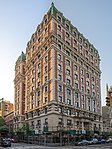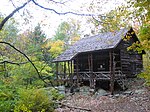American LGBTQ+ Museum
LGBT organization stubsLGBT organizations in the United StatesManhattan building and structure stubsMuseums established in 2017New York (state) museum stubs
The American LGBTQ+ Museum is a museum in development on the Upper West Side of Manhattan that will focus on New York City's LGBTQ history. It will be part of the campus of the New-York Historical Society, which is undergoing a 70,000 square feet (6,500 m2) expansion, and is slated to open in 2024. Under the leadership of Richard Burns, the museum's board chair, planning for a museum began in 2017. Ben Garcia was named the museum's first executive director in January 2022.
Excerpt from the Wikipedia article American LGBTQ+ Museum (License: CC BY-SA 3.0, Authors).American LGBTQ+ Museum
Central Park West, New York Manhattan
Geographical coordinates (GPS) Address Phone number Website Nearby Places Show on map
Geographical coordinates (GPS)
| Latitude | Longitude |
|---|---|
| N 40.779 ° | E -73.974 ° |
Address
New-York Historical Society
Central Park West 170
10024 New York, Manhattan
New York, United States
Open on Google Maps







